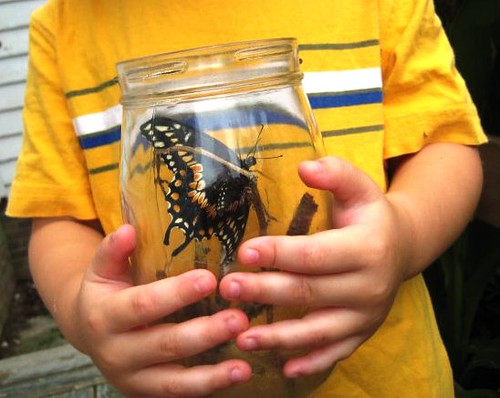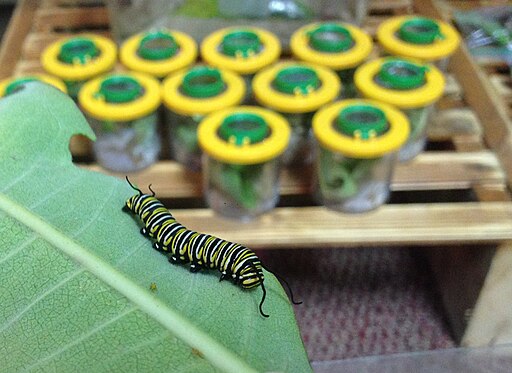In our last article, we talked about enjoying one of the most important relationships you can find in your garden: that between native plants and caterpillars. It’s so vital because caterpillars require specific host plants to complete their life cycles, and they also serve as crucial cogs in the food chain.
The last article was about how to find caterpillars in your garden, and this one will address another common question: the experience of bringing caterpillars inside to raise them. This can be a rewarding experience, especially when introducing children to the wonders of nature. However, this practice comes with considerations that may affect caterpillar populations and ecosystems.
Benefits of Raising Caterpillars Indoors

There are certainly some good reasons why people are drawn to the activity of bringing caterpillars inside to rear them and then release them back into the wild.
One common reason is sharing the experience with children, for whom watching a caterpillar grow, pupate, and eventually transform into a butterfly or moth can be a magical experience. Doing with this with children fosters a deep appreciation for the natural world and can spark a lifelong interest in native plants, wildlife gardening and conservation.
Other reasons for raising caterpillars to butterflies inside have to do with protecting them and giving them a better chance at life. Since large percentages of caterpillars do not make it to adulthood, due to predation from birds, parasitic wasps, and other hazards, raising them indoors can significantly increase their chances of survival.
For some popular species, especially monarchs, dwindling numbers and their endangered status leads many enthusiasts to start rearing
While these benefits are appealing and certainly understandable, it’s important to consider potential negative effects if your goal is to support native ecosystems and caterpillar populations.
Potential Cons of Raising Caterpillars Indoors
The Xerces Society is a foremost authority on invertebrate conservation, and in an article titled “Keep Monarchs Wild,” the organization explains “why captive rearing Isn’t the way to help monarchs.” They outline some of the reasons why these good intentions towards individual caterpillars don’t actually translate to better outcomes for the populations as a whole, points which are supported by academic research including this review article published in the Annals of the Entomological Society of America. Some of the reasons:
- Disruption of Natural Selection: By raising caterpillars indoors, you may inadvertently interfere with natural selection processes. In the wild, only the strongest and most adapted individuals survive to adulthood. When we protect caterpillars from their natural challenges, we may unintentionally weaken the genetic pool.
- Impairment of Migratory Instincts: For species like monarch butterflies, indoor rearing may disrupt their natural migratory instincts. Environmental cues such as temperature and daylight play crucial roles in signaling when it’s time to migrate. Caterpillars and butterflies raised indoors may not receive these cues, potentially leading to disorientation and reduced survival rates during migration.
- Risk of Disease Transmission: Caterpillars raised in close quarters indoors are at a higher risk of spreading diseases like Ophryocystis elektroscirrha (OE) in monarchs. In the wild, diseased individuals are more likely to be eliminated, reducing the risk of spreading pathogens. Indoor rearing can lead to the unintentional release of infected butterflies, which could spread diseases to wild populations.
- Impact on Local Populations: In some cases, collecting too many caterpillars from the wild can negatively impact local populations. While a single enthusiast will likely have a negligible effect, widespread collection could reduce the number of butterflies and moths that reach maturity, potentially impacting pollination and the broader ecosystem.
Our Verdict: Should You Raise Caterpillars Indoors?

Given these motivating factors for rearing caterpillars inside and balancing them against the potential risks, what’s the best decision to make?
Ultimately, we believe that if you greatly enjoy the process of guiding a caterpillar through its life cycle, and especially if you want to do it as an activity with children, it’s certainly okay to do so. But limiting the number is a good practice to avoid significantly impacting local populations. Just raising one or two at a time allows you to enjoy the educational benefits without removing a substantial number of individuals from the wild.
And there are a couple of other important best practices for raising caterpillars. First, ensure you have enough of their host plants: If you’re rearing monarchs, they need a LOT of milkweed. Other caterpillars also need a large supply of their host plants, so make sure you research their food plants and are able to provide enough to sustain them through the rearing process.
Also, make sure you practice good hygiene. Cleanliness is critical to prevent the spread of disease among caterpillars. Regularly clean their enclosures, remove frass (caterpillar waste), and avoid overcrowding to reduce the risk of infection.
Overall, seeing your child light up when the caterpillar you brought inside emerges as a butterfly can be an extremely experience, and may spark a lifelong interest in native plants and conservation. This is a much different proposition than rearing large numbers of caterpillars in an ill-advised attempt to benefit the larger population.
But even with that said, we believe there is an even better way to share the joy of the caterpillar life cycle without needing to bring them indoors.
Even Better Ways to Engage with Caterpillars: Creating a Caterpillar-Friendly Garden
You don’t need to bring a caterpillar into your home in order to participate in their life cycle. A solution that’s even more beneficial for the ecosystem is to grow or expand your native plant garden to attract and support even more caterpillars through the cycles of the seasons.
Make sure to plant a variety of native species that caterpillars need for food and shelter, including both host plants for larvae and nectar plants for adults. This approach allows you to observe caterpillars in their natural habitat, contributing to their survival without disrupting their life cycles.
Also make sure you are creating safe yard habitats for wildlife including caterpillars, including reducing pesticide use, leaving leaves, stems, and overwintering habitat, and related practices.
If you’re interested in making an even bigger impact, you can even join citizen science projects that track butterfly and moth populations. By observing and reporting caterpillars and adult butterflies in your area, you contribute valuable data to researchers and help monitor the health of these species. These days with a proliferation of smartphone apps like iNaturalist it’s easier than ever before to join a community of like-minded individuals with similar ecosystem motivations.
Leave a Reply